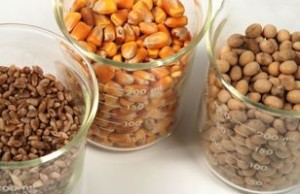 Grain futures advanced on Tuesday. Corn extended Mondays gains as analysts expect the USDA to trim its corn output forecast. Meanwhile, Japan is planning to buy more than 26 000 metric tons of U.S. wheat. Soybeans advanced more than 1%.
Grain futures advanced on Tuesday. Corn extended Mondays gains as analysts expect the USDA to trim its corn output forecast. Meanwhile, Japan is planning to buy more than 26 000 metric tons of U.S. wheat. Soybeans advanced more than 1%.
On the Chicago Board of Trade, corn futures for September delivery traded at $5.4163 a bushel at 10:33 GMT, up 1.54% on the day. Prices held in range between days high and low of $5.4238 and $5.3463 a bushel respectively. The grain has advanced almost 3% this week after losing around 21% in the preceding two weeks.
Corn advanced for a second day following its steepest gain since three weeks on Monday as analysts expected the corn harvest in the U.S. to total 13.983 billion bushels this year, below the previous prediction of 14.005. The U.S. Department of Agriculture will update its production outlook on July 11.
Tetsu Emori, a commodity fund manager at Astmax Asset Management Inc., said for Bloomberg: “The December contract has already hit a bottom. If the USDA reduces its supply estimate as hot weather stresses crops, we’re looking at higher prices. Weather conditions are uncertain.”
In its weekly crop progress report on Monday, the USDA said that corn silking fell behind last years pace. As of the week ending July 7, 6% of the corn crop was silked, slightly above the preceding weeks 3%, but well below last years 46% and the five-year average 20%.
As for the corn crop conditions, the USDA reported it is a lot better than 2012. As of July 7, only 8% of the crop was categorized as “Very poor” and “Poor”, 24% was “Fair” and 68% was of “Good” and “Excellent” qualities. In comparison, during the same week last year, 36% of the crop fell in the “Very poor” and “Poor” categories, 30% in “Fair” and 40% was categorized as “Good” and “Excellent”.
The U.S. Department of Agriculture reported last Friday of June that 97.4 million acres of land was sown to corn, the highest since 1936. U.S. Increased production is expected in the U.S., European Union and Ukraine and other former Soviet Union countries.
Wheat advances
Wheat advanced for a second straight day as well as investors speculated that low prices due to ample global supply may attract importers into filling stockpiles. As reported last week, Egypt purchased 180 000 metric tons of Ukrainian and Romanian wheat.
On the CME, wheat futures for September delivery traded at $6.6750 a bushel at 10:33 GMT, up 0.59% on the day. Prices ranged between days high and low of $6.7063 and $6.6250 per bushel respectively.
Meanwhile, Japan is seeking to buy U.S. wheat as an alternative to the genetically modified Oregon wheat, whose import in the Asian country was suspended. The suspension was extended for a sixth week. Japan plans to buy 23 963 metric tons of club wheat grown in Washington state, 1 710 tons of soft-red winter, 1 497 tons of Australian premium-white and 22 784 tons of western-red-spring wheat from Canada.
In its acreage report in the end of June, the U.S. Department of Agriculture said that the planted area for 2013 will equal 56.5 million acres, 1% higher than last year. The 2013 winter wheat planted area equals 42.7 million acres, 3% above last year and up 2% from the previous estimate.
The International Grains Council said last week that global wheat production may rise 4.2% compared to a year earlier and total 683.1 million tons, 1 million more than the previous estimate. The USDA expects global output to surge by 6.1% to 696 million tons.
The USDA said in its weekly crop progress report on Monday that 57% of the U.S. winter wheat crop was harvested as of July 7, compared to 43% a week earlier. This however was below last years 78% and the five-year average 64%.
As for the spring wheat crop, 98% had emerged as of last week, compared to 93% during the preceding one, but below last years full emergence and the five-year average 99%.
As for the spring wheat condition, the USDA reported that this years crop is of relatively the same quality like last years. As of July 7, 5% of the crop was categorized as “Very poor” and “Poor”, 27% was “Fair” and 72% was of “Good” and “Excellent” quality. Meanwhile, 7% of last years crop fell in the “Very poor” and “Poor” categories, 27% in “Fair” and the remaining 56% in “Good” and “Excellent”.
Soybeans advance as well
Soybeans also extended yesterdays gains and surged 1.35% on the day by 10:24 GMT. Soybeans for August delivery traded at $14.7500 per bushel, ranging between daily high and low of $14.7563 and $14.5250 per bushel respectively. The oilseed has gained 3% so far this week after closing 0.19% higher the preceding one.
Like corn, farmers are expected to reap a record amount of soybeans this year. The USDA said in its acreage report in the end of June that the U.S. soybean planted area is estimated at a record high of 77.7 million acres, up 1% compared to last year. Area for harvest, at 76.9 million acres, is up 1% from 2012 and will also be a record high, if realized.
However, soybeans were supported as a sailor strike at Argentinas Timbues/San Lorenzo port disrupted grain shipments. Tetsu Emori commented for Bloomberg: “China is probably struggling to import soybeans and soybean meal from the U.S. after the Argentine strike.” China is the worlds biggest consumer while the U.S. is the top grower and exporter.
Soybeans were pressured throughout June as reduced demand forecasts from the oilseed’s biggest consumer, China, weighed on prices. All of the country’s PMI readings showed worse figures than the preceding month and the country received several downward revisions of its GDP growth forecast, including one from Goldman Sachs, according to which China’s economy will expand by 7.4% in 2013, down from 7.8%.
In its weekly crop progress report, the USDA said that as of July 7 95% of the nations soybean crop had emerged, up form the preceding weeks 91%, but below last years full emergence and the 97% five-year average.
As for the soybeans condition, the government agency reported it was a lot better than last years. This year, 7% of the crop was categorized as “Very poor” and “Poor”, 26% was “Fair” and 67% was “Good” and “Excellent”. As of July 7, 2012, 27% of the crop was of “Very poor” and “Poor” quality, 33% was “Fair” and the remaining 40% was of “Good” and “Excellent” quality.





